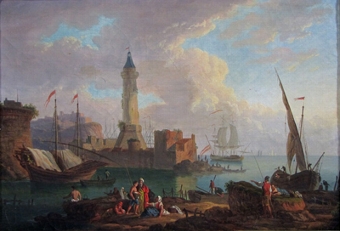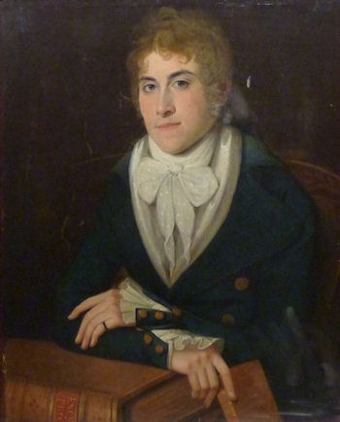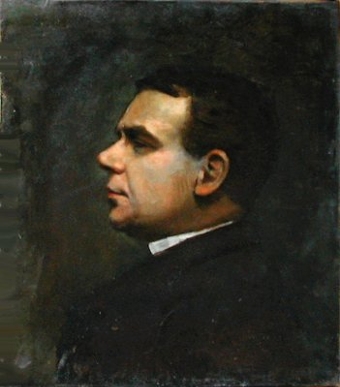featured item

quality pair of antique edwardian postal scales and weights Read more
portrait of victor bonney md, frcs, 1872 -1953
- View other items in:
- antiques interior design modern and vintage
- other interior design
artware ltd
Enquire about this antique
Artware Ltd has 565 antiques for sale.
click here to see them all
Bonney was born in West London in 1872: both his father and his paternal grandfather were family doctors. Bonney, son and the grandson of doctors, was brought up in Victorian days in a tall house in Chelsea. It had a well-wooded back garden in which he and his brothers could play. His parents were artistic and there was a procession of singers and musicians coming through the house performing. He was at first educated at home and did not go to Miss Parker''s Day School until he was nine. Influenced by the careers of his father and grandfather, Victor Bonney had always wanted to go into medicine. He took the Cambridge Local Examination in 1887 and passed with First Class honours. In 1891, he started medicine at St. Bartholomew''s Hospital Medical School; he enjoyed a few months there but transferred to the Middlesex Hospital Medical School very soon. This was a hospital renowned for a consultant staff serving the Royal Household and providing Presidents for the Royal Colleges. He worked his way through the medical school until the finals where he passed the Conjoint Examination in Obstetrics and Surgery easily but failed in Medicine. He realised that he had to settle down and started to work. He tied facts together logically so that he did not have to remember isolated events but looked for trends that linked them together. In 1896 he passed Medicine with Distinction and went on to take the London MB in all parts and again he gained Distinction. He became a house physician but fell foul of the great Sir Douglas Powell for two reasons. Firstly, he often saw and treated patients before his superior had arrived at his weekly visit; secondly, his notes were brief, containing only the relevant facts. His superiors were also to some extent unhappy about Bonney''s popularity as a teacher of students and so when he applied to become a Senior House Officer at the Brompton Hospital he was unsuccessful for his two previous chiefs had blackballed him. He applied back at the Middlesex for a medical post but again was not supported.
It was probably a chance meeting with the great gynaecologist Sir John Bland Sutton in the corridor of the Middlesex that led to Bonney taking up a career in gynaecology. Sir John enquired about his old student''s career and, on hearing the story, he is alleged to have said ''We want a House Surgeon at Chelsea, the job is vacant. I will see you get it if you apply''. This is a little different from the processes doctors have to go through to get into jobs these days. A resident''s post at Chelsea Hospital was followed by one at Queen Charlotte''s and he then returned a year later to be a Registrar at Chelsea Hospital. He became Outpatient Gynaecologist in 1903 to that hospital and a Registrar in the subject at the Middlesex. In 1905, he married Annie Appleyard, a Tasmanian nurse who was a sister at Chelsea Hospital. He met her, wooed her and married her but sadly within two years of this marriage Annie had menorrhagia severe enough to drop her haemoglobin critically. After much consideration it was agreed that she should have a hysterectomy at the Middlesex Hospital. This was done and a single fibroid was found at the fundus. It was the end of the Bonney''s hopes of a family and Victor always remembered this. It turned his mind towards conservative surgery for benign conditions of the uterus and ovary and influenced his whole career. In 1907 he became an Assistant Gynaecological Surgeon but still did not have any inpatient beds - but two years later Bonney became a full gynaecologist at the Middlesex Hospital and in 1913 filled the same post at Chelsea Hospital for Women. The great professional achievement was surgery for carcinoma of the cervix. He, along with Comyns Berkeley pioneered this operation in Britain and the Empire. The Wertheim hysterectomy was not popular in this country for it was a very difficult operation but Bonney mastered it. He by now was in the full flood of his work, rising early in the day, writing before breakfast sometimes walking across the park from his home in Harley Street to Chelsea Hospital. He would consult in the hospital all day and in the later afternoon see private patients. In the early evening he would do research and write.
Bonney was not however a dull man, He was a very sharp dresser, always in dark suits with a fresh carnation in his buttonhole each day of the year. He and Annie always dressed and dined formally in their home even though they were alone and afterwards would often go out to a night club to dance for a few hours for they were both extremely good sleek dancers. He had the habit of calling everyone (male and female) ''Darling'' which was endearing to some but irritated others and was frankly astonishing when some six foot Australian gynaecologist met him for the first time and was addressed as ''Darling''. Bonney drove smart cars around London and as his practice grew, he acquired two chauffeurs; his total staff was thirteen at home including his secretaries and he worked them all hard. When the First World War started, Bonney went to the War Office to volunteer but was told rather briskly that gynaecologists were not required, and rather rudely reminded that ''the days of Amazons had passed''. He and Comyns Berkeley spent the war running the convalescent home of the Middlesex Hospital down at Clacton-on-Sea. They would go there turn and turn about, three days each working in London or down at Clacton. Whilst at Clacton they were the only Medical Officers so performed all sorts of duties from taking X-rays to doing major abdominal and thoracic surgery. In addition they treated trench fever, gassed soldiers, burns and over four thousand cases of gunshot wounds. The journey was done after dark, trains were irregular and cold. This journey, twice a week through four long years, must have taxed Bonney.
He still kept his work going on the other three days at the Middlesex and Chelsea Hospitals both in cancer and in conservative surgery. It must be remembered that when Bonney was at his height there were no antibiotics so antisepsis had to be strict, hence the invention of Bonney Blue. Further, there was little organised blood transfusion available and so blood had to be conserved even on the major Wertheim operations. Anaesthesia was not as developed as it is now and Bonney got through an enormous load, much of it in private in the homes of the rich in London. He would have two operating teams and two motor cars, leapfrogging from one to another allowing him to arrive and depart promptly so performing up to four major operations in a morning in four different sites. As mentioned previously, his work on conservative gynaecological surgery is one of his memorials. He believed strongly that fibroids should be removed, shelled out from the uterus of the women who were of childbearing age, leaving the organ behind. The old arguments that the uterus would be useless after such surgery he proved wrong and by the invention of his myomectory clamp, the symbol of the Victor Bonney Society, he was able to control blood flow to and from the uterus. This gave him a bloodless field and he would remove many fibroids with a single incision, always in the anterior wall of the uterus. By the same token, ovarian surgery was influenced by Bonney''s conservative attitude. Benign tumours of the ovaries were displaced from the organ leaving a shell of active ovarian tissue, which he would restore, by buckling up the cavity with a continuous suture and another is used to bring the edges together. This restores a working ovary, producing both oocytes and hormones. His work on cancer of the cervix has probably overshadowed much of the conservative surgery for he performed over seven hundred Wertheim hysterectomies in his life with very low death rates bearing in mind the conditions under which he was operating. He was a meticulous surgeon for he had learned his anatomy well and he always searched the area for nodes, dissecting boldly but carefully. Between the Wars, Bonney''s reputation rose and he was invited to lecture in other parts of the world, he enjoyed this for he was a gregarious man. However, he did not like operating in strange operating theatres for on one occasion this was associated with a death in New Zealand, which haunted him.
In the late 1920s London only had two Royal Colleges in medicine, that of Physicians then in Trafalgar Square and the second of Surgeons in Lincoln''s Inn Fields. Blair Bell, an obstetrician from Liverpool and Fletcher Shaw from Manchester conceived the idea of starting a college for obstetricians and gynaecologists. All the eminent were asked to become Founder Members. Bonney, who by this time was on the Council of the Royal College of Surgeons, refused. He was sure that such a college would be neither fish nor fowl and would dilute the effort of gynaecology in surgery. He felt that the right place for gynaecologists was in the Royal College of Surgeons. After much internicene college bickering, the College of Obstetricians and Gynaecologists was founded in 1929. Bonney, to his eternal credit, never spoke out publicly against his colleagues of the new college. After the WWII he accepted an Honorary Fellowship of the, by then, Royal College of Obstetricians and Gynaecologists. He had fought a long fight to keep gynaecology as a sub-speciality of surgery but the bond with obstetrics was too strong and since then the main subject of obstetrics and gynaecology has blossomed. It is interesting that since Bonney''s time sub-specialities have developed in the RCOG and it may be that gynaecology will separate from obstetrics in the future. As the years passed, Bonney did not seem to age. He still had enormously long operating lists, travelling round London performing dexterous surgery. He retired from his two teaching hospitals in London in the late 1930s aiming to live quietly in his home, Seabournes, on the River Wye. The Second World War however intervened and he came back to do a locum at Hereford Hospital for the whole of the War to release a younger man to go to the armed services.
After the Second World War Bonney recognised that his operating skills were diminishing. He led a quiet life in Wye with many visitors from all around the world. In 1949 he was f?ted at Guest of Honour at a conference on malignancy in Newcastle and gave his last scientific paper there. He had a coronary thrombosis in 1953 at his home after developing a chest infection, and was transferred to the Middlesex Hospital where, after a cerebrovascular accident, he died on July 4th of that year. He was buried at Putney Vale Cemetery next to his father.
Bonney''s professional achievements and his fame among colleagues were firstly for his extraordinary performance of 500 Wertheim radical extended hysterectomy operations for cancer of the cervix and, secondly, for his development of the conservative operations of myomectomy and ovarian cystectomy. His radical hysterectomy saved the lives of many women who would otherwise have died from painful and debilitating cancer of the cervix; and his conservative operations preserved the fertility of many women who would otherwise have been childless. His motivation for the development of the second type of operation was the experience of his wife Annie, who became grossly anaemic from heavy menstrual periods and underwent a hysterectomy, the only treatment then known. So within two years of marriage she was made sterile. Ten days after the operation Annie''s bowel obstructed. A great surgeon Bland Sutton dealt with that. Bonney inevitably became interested in conservative surgery and in bowel function after major surgery; so in the end he developed not only the operation of myomectomy to remove fibroids and conserve the uterus, but also ovarian cystectomy to remove non-malignant cysts while conserving ovaries. Chamberlain has managed to detail the events of Bonney''s professional and social life in context with the very dramatic world events that occurred in his life. In the First World War Bonney and his consultant colleague Comyns Berkeley were, because of the work they were doing, prevented from joining the forces, which Bonney would very much have liked to do. They continued practising, each for half a week in London and half a week in Clacton, Essex. In London they continued working at the Middlesex Hospital and at the Chelsea Hospital for Women, as well as maintaining some private practice. Chamberlain details Bonney''s particular contributions made by designing surgical instruments such as the special clamp sometimes still used for diminishing the blood loss at myomectomy. Another instrument was for lessening the blood loss at lower-segment caesarean operations. Bonney was one of the first to insist on delivering babies by caesarean section through the lower segment when necessary.A very important part of the book concerns Bonney''s reaction to the establishment of a College of Obstetricians and Gynaecologists, which is now the Royal College. He was very much against the College, holding that both gynaecology and (somewhat illogically) obstetrics were branches of surgery. He was on the Council of the Royal College of Surgeons of England for a long time and, because he attended most of the council meetings, was very important there. But despite achieving high office he never became President of the Royal College of Surgeons, which he probably hoped he might. In his early opposition to the College of Obstetricians and Gynaecologists he refused to join, but later in life he was persuaded to accept their Honorary Fellowship.
Outside medicine Bonney''s great hero was Rudyard Kipling, who was his friend. Chamberlain has headed each chapter of the book with a quotation from Kipling.Bonney''s skills were not limited to the operating theatre. He wrote many books, some together with Comyns Berkeley. The most important of these were their textbook of gynaecological surgery, which went to six editions, and Bonney''s very notable Extended Myomectomy and Ovarian Cystectomy. Both books had illustrations by Bonney. He wrote hundreds of articles for a host of journals including the JRSM (then the Proceedings). His hobbies were dancing, in which he and his wife excelled, painting water-colours and fishing which he managed to do in rivers all over the world but in particular at Seabournes, his country home on the beautiful River Wye in Hereford.Fifty-three years ago, I had the honour to assist Bonney at one of his last myomectomies and then to drive him around the haunts of his childhood in West London, when he recounted some of the things that Chamberlain now records in a work notable for its sympathy, accuracy and fairness.
Antiques.co.uk Ref: T7KVJUPH
- Materials:
- Oil on Canvas
- Width (cm):
- 48.26 x 43.18 cm 19.00 x 17.00 ins
Artware Ltd
Artware Fine Art specialises in fine antique, decorative and historical portraits and topographical pictures . We cover a period from the 17th and 18th centuries through to the 19th & 20th Centuries. We have over 150 portraits in stock, which can be viewed on our web site, each historical portrait has well researched biographical information both on the sitter and the artist.
Contact details
18 La gare
51 Surrey row
London
Greater London
SE1 0BZ
UNITED KINGDOM
T: 0207 921 97904
E: greg@artwarefineart.com
W: www.artwarefineart.com











